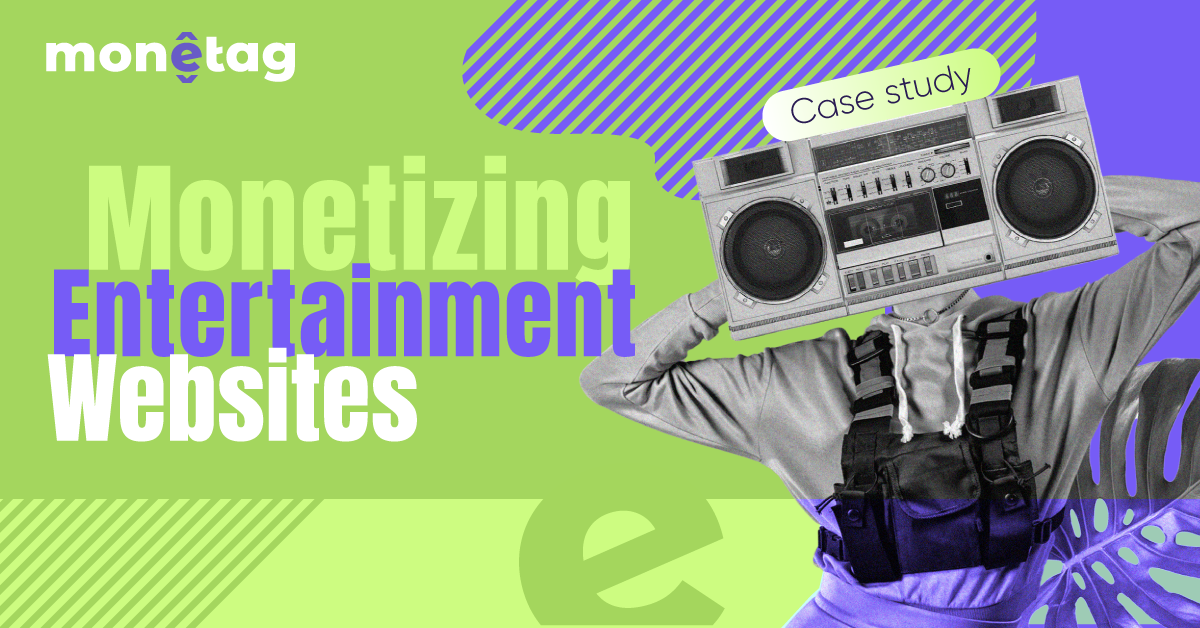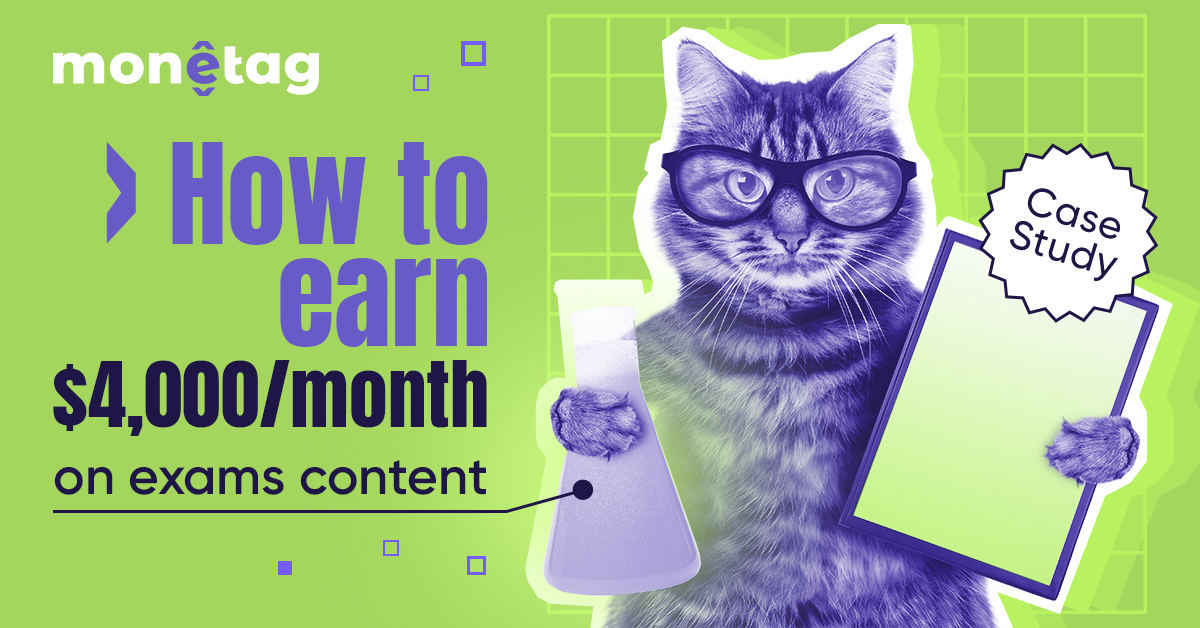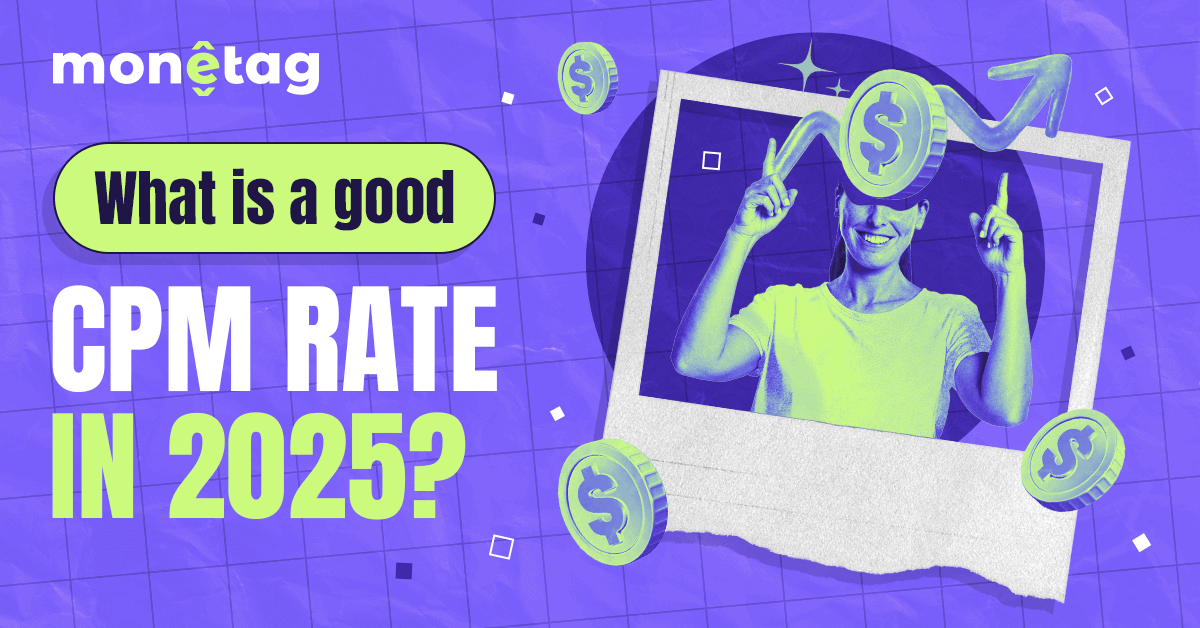| Service | Why choose over Taboola | Things to consider | Best for |
|---|---|---|---|
| Monetag | Lower entry, diverse formats, fast payout | More visible formats, mobile/remnant | Small/medium, global |
| Outbrain | Premium network, content engagement | High traffic/pricing, slower approval | Large, premium content sites |
| Adsterra | All formats/traffic, instant onboarding | Intrusive formats, global, fast setup | Any size, mixed inventory |
| MGID | High rev share, easy interface | Smaller reach, best for niche/new | Niche/new content publishers |
| Adblade | Cheaper, unique ad units | Slightly smaller reach, direct deals | Cost-effective, direct sites |
| Publift | Header bidding, multi-source yield | Tech setup, broad inventory | Small/medium, multiple demand |
| Setupad | Programmatic/header bidding, flexibility | Tech onboarding, many formats | Medium size, maximization |
What is Taboola and Why Look For Alternatives?
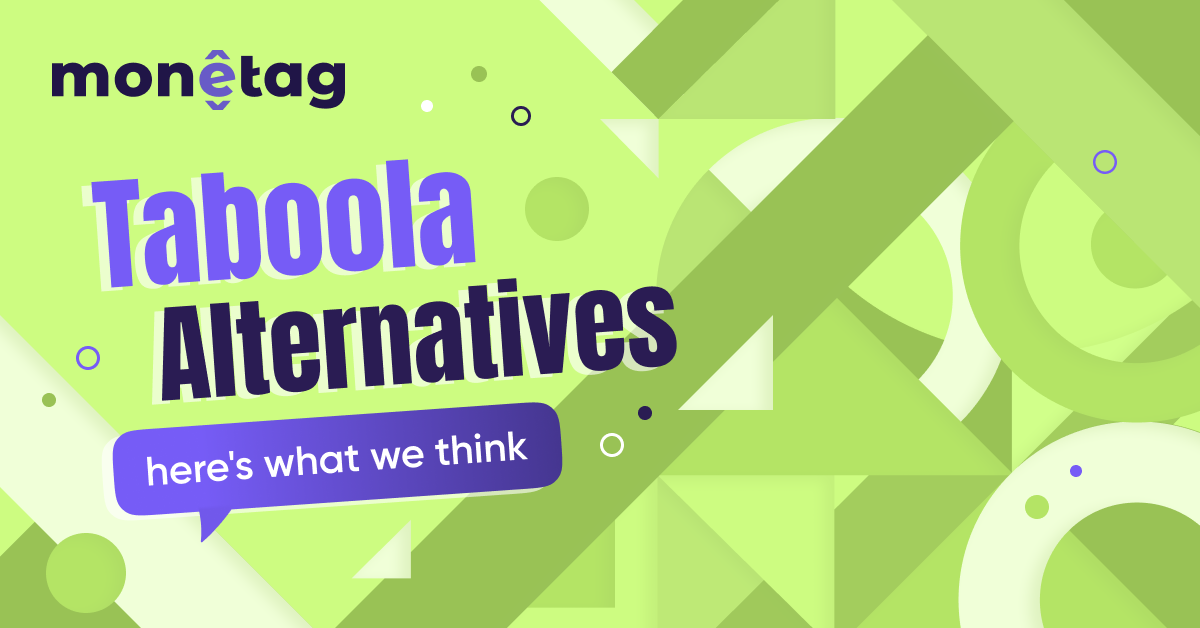
If you’ve spent time reading online articles, you’ve almost certainly seen Taboola ads. They usually appear at the bottom of a page with headlines like “You might also like…” or “Recommended for you.” That’s Taboola’s specialty: native advertising that blends with content and drives traffic to other sites.
So, what is Taboola exactly?
It’s one of the world’s largest content discovery platforms, helping publishers monetize by recommending sponsored stories, articles, and videos. Taboola partners with major media outlets and connects them with advertisers through its network.
But while Taboola is a major player, it’s not the perfect fit for every publisher. Here are a few reasons why website owners look for alternatives to Taboola:
- Traffic requirements: Smaller publishers often struggle to get approved.
- Taboola pricing: Advertisers usually need significant budgets to compete effectively, which can limit opportunities for niche sites.
- Revenue share: Payout terms aren’t always as favorable as those of other platforms.
- Ad control: Some publishers feel Taboola gives limited customization over ad placements.
If you’re running a blog, news site, or niche website, these limitations can be frustrating. Taboola alternatives offer more flexibility, easier onboarding, and often better monetization for small and mid-sized publishers.
Summary of Taboola alternatives
1. Monetag: The best Taboola alternative for small and large publishers
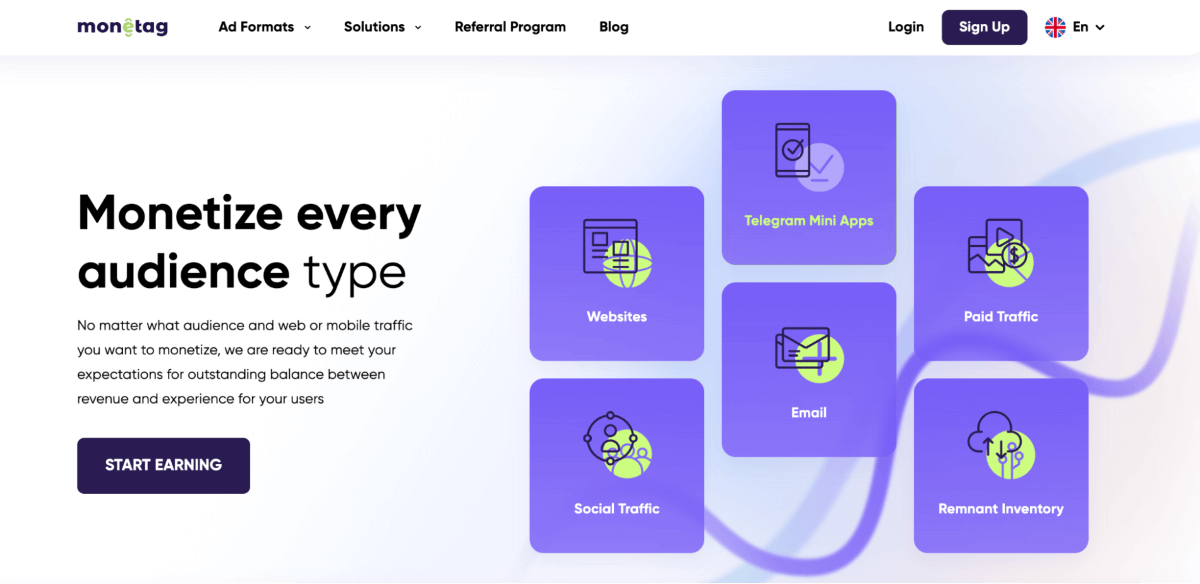
When it comes to finding a flexible, beginner-friendly, and revenue-driven Taboola alternative, Monetag is often the first choice for publishers. Unlike Taboola, which can feel out of reach for smaller sites, Monetag is built to work for everyone, from bloggers just starting out to established media publishers with global traffic.
Why Monetag stands out compared to Taboola
- No strict traffic requirements
You don’t need millions of monthly views to start earning. - Multiple ad formats
Push notifications, in-page push, banners, smartlinks, popunders, and more. This makes Monetag far more versatile than traditional native networks like Taboola. - Fast, flexible payouts
Weekly withdrawals starting from just $5, with multiple payment options. - Global advertiser base
Monetag partners with trusted advertisers across regions, giving you consistently high fill rates no matter your audience location. - Safety first
Every campaign is scanned with anti-fraud and malware detection technology to protect both you and your visitors. - Easy integration
Monetag supports API, XML, SDK, and simple link-based integrations, so you can plug in ads without technical hassle.
Who Monetag is best for
Monetag is a strong choice for:
- Small publishers who want a low barrier to entry.
- Growing websites that want scalable monetization across different ad formats.
- Experienced publishers who want extra revenue streams alongside other networks.
Real results: Case studies worth reading
If you’d like to see how Monetag performs in practice, check out these case studies from the Monetag blog:
These real-world examples show how publishers across niches and geographies use Monetag to grow ad revenue, often outperforming traditional Taboola ads in both earnings and flexibility.
2. Outbrain
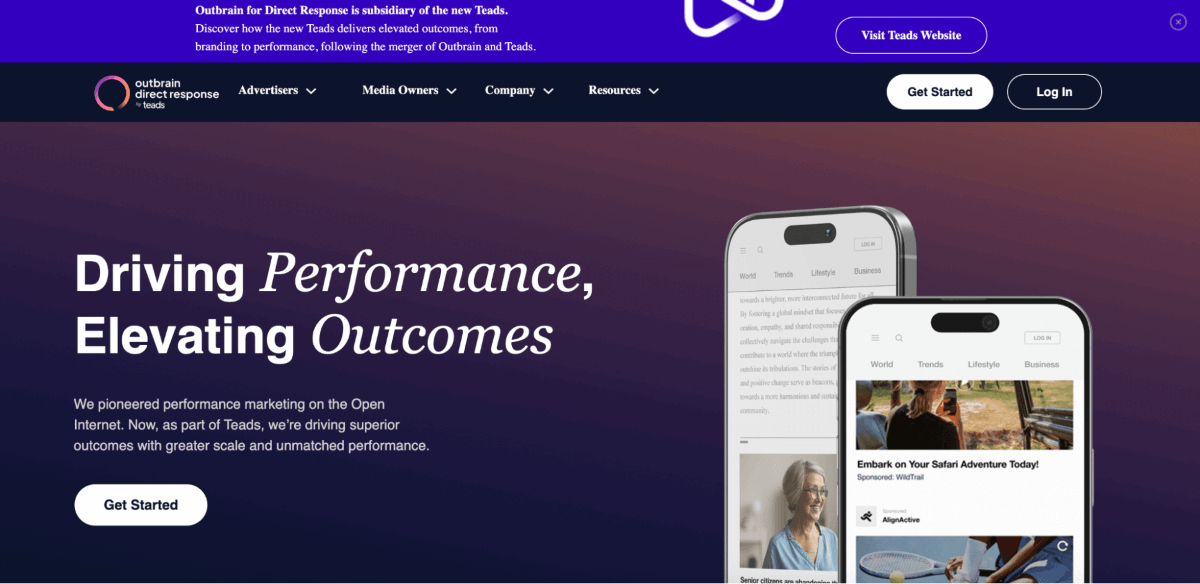
If Taboola has a direct competitor, it’s Outbrain. The two platforms are often mentioned together because they both dominate the native advertising space and use similar “recommended content” widgets on publisher sites.
Why choose Outbrain over Taboola?
- Premium network focus
Outbrain targets larger, established publishers and high-tier traffic; Taboola’s network is broader but sometimes less premium. - Quality and engagement
Outbrain’s placements are usually on higher-engagement, premium news outlets, ideal for brand-building.
- Content approval process
Outbrain provides stricter vetting for sponsored content, possibly leading to higher trust.
Things publishers should consider
- Traffic requirements for Outbrain are similar to Taboola — smaller sites may struggle to qualify.
- Outbrain campaigns may be slower to approve, but can yield better results for quality, engagement-driven content.
- Taboola offers easier access for e-commerce and mixed content sites.
Who is Outbrain best for?
- Large publishers focusing on brand safety, high-quality engagement, and established content.
- Publishers with storytelling, informative, or news content targeting premium audience
Bottom line: Outbrain is a solid alternative to Taboola if you already run a larger website and want to stay within the premium native ad ecosystem. But for small publishers or those seeking more flexible ad formats, platforms like Monetag are usually the better fit.
3. Adsterra

Another strong Taboola alternative is Adsterra, a global ad network that’s especially popular with small and mid-sized publishers. Unlike Taboola or Outbrain, which mainly focus on native content recommendations, Adsterra offers a wide range of monetization formats, making it much more flexible.
Why publishers choose Adsterra
- All traffic/all formats accepted
Adsterra supports virtually any legal traffic type and diverse formats, including popunders, push, video, native, and display. Taboola is limited to native.
- Instant onboarding, very low payout
Adsterra approves new sites in minutes and pays out starting at $5. - Advanced anti-fraud and optimization tech
Useful for maximizing monetization from varied geos and formats.
Things publishers should consider
- Adsterra’s ad types can be more intrusive or less premium compared to Taboola’s native placements.
- Strong moderation and fraud controls, but be mindful of user experience impact from popunders/push.
- Easiest for blogs, mobile, and international traffic.
Who is Adsterra best for?
- Publishers of any size seeking fast monetization, multiple ad formats, and global coverage.
- Sites with remnant or mixed-content inventory, including blogs, social, and apps.
Bottom line: While Taboola ads and Outbrain ads mainly serve larger publishers with premium placements, Adsterra is one of the best Taboola alternatives for small publishers who want flexibility, speed, and variety in ad formats.
4. MGID
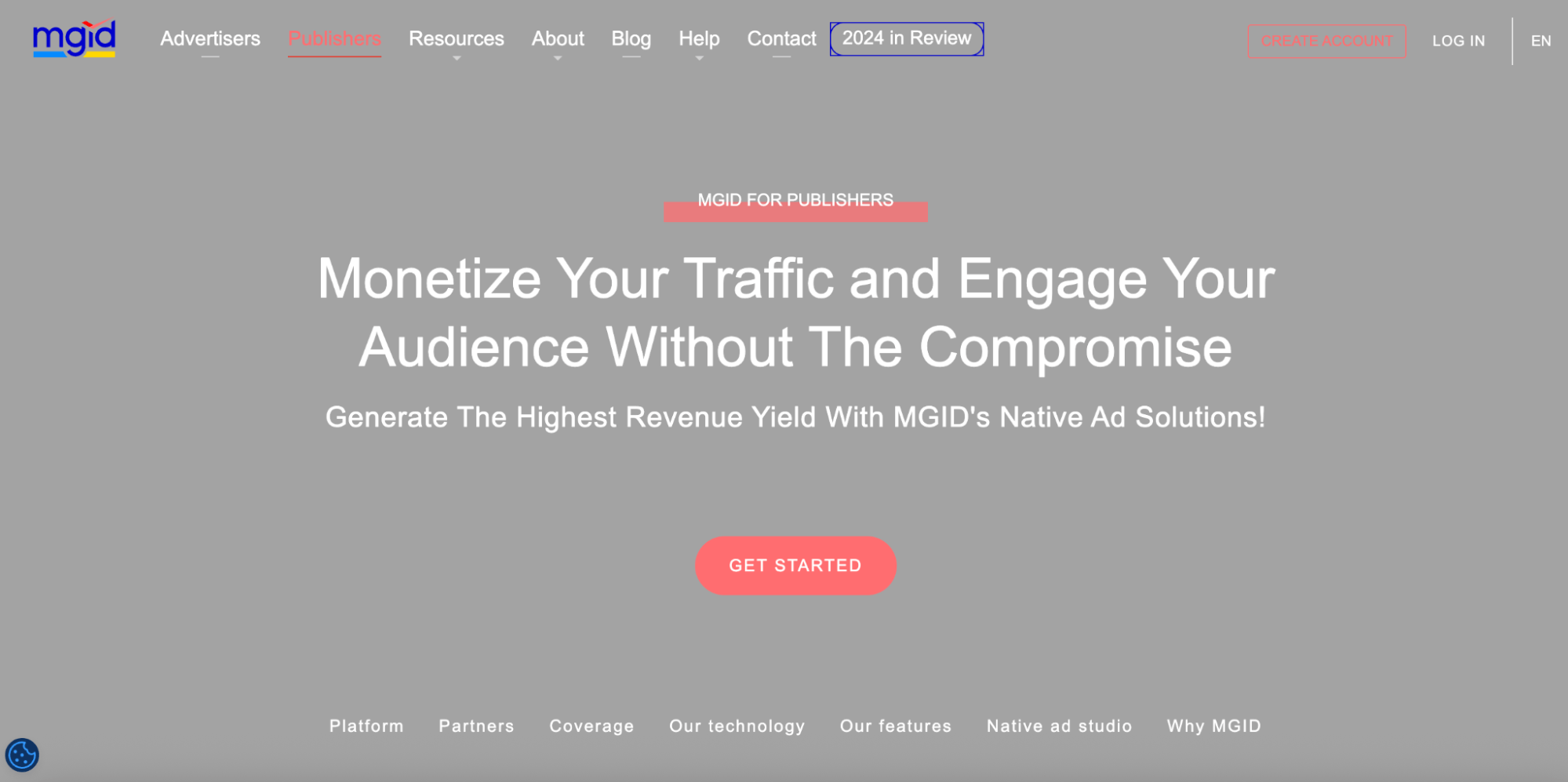
MGID is another well-known name in the native advertising space and a popular alternative to Taboola. Like Taboola ads, MGID specializes in sponsored content recommendations that blend with a site’s articles. However, it takes a more publisher-friendly approach in several ways.
Why publishers consider MGID
- Higher revenue share
MGID typically offers a greater percentage to publishers vs Taboola (up to 65% vs Taboola’s ~50%). - Intuitive interface and lower minimums
Publishers find MGID easier to use compared to Taboola.
- More personalized native ad formats
Often easier for niche sites and new publishers to join
Things publishers should consider
- MGID’s reach is smaller, and CPMs may be lower than Taboola for large, tier-1 audiences.
- MGID excels in non-premium and niche markets, but Taboola offers greater scale and brand safety.
- MGID’s moderation and ad approval process is faster and more flexible
Who MGID is best for
- Niche or new publishers, as well as those prioritizing ease of use and a higher revenue share.
- Owners of content sites not qualifying for Taboola’s traffic minimums but still wanting native monetization
Bottom line: If you want to stay in the native advertising world but find Taboola pricing, approval, or ad control too restrictive, MGID is a reliable Taboola alternative to test.
5. Adblade
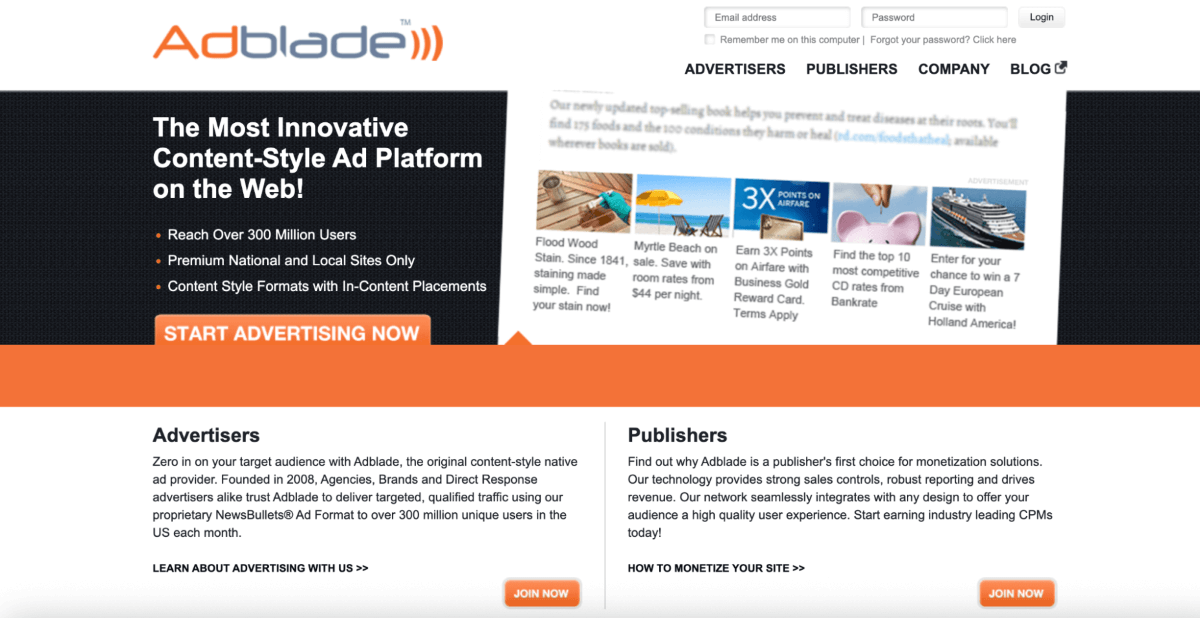
Adblade is a U.S.-based ad network that focuses on content-style advertising, making it a natural alternative to Taboola. It’s often used by news outlets and publishers in professional niches who want to monetize without cluttering their pages with intrusive ad formats.
Why publishers choose Adblade
- Cost-effective for smaller publishers
Adblade is cheaper to implement and more accessible regarding minimums.
- High-impact and unique ad units
Supports proprietary formats such as NewsBullets for higher CTR.
- Direct relationships
Adblade focuses on direct deals and relationships rather than programmatic, which can lead to more stable revenue.
Things publishers should consider
- Adblade ratings are just below Taboola on overall score, suggesting a slightly smaller ecosystem and reach.
- Taboola still leads in brand, tech, and total audience.
- Adblade works better for sites focused on news, finance, and high-impact ads.
Who is Adblade best for
- Smaller publishers and those wanting cost-effective alternatives to Taboola.
- Publishers wanting unique, direct-placement formats instead of mass-scale programmatic.
6. Publift
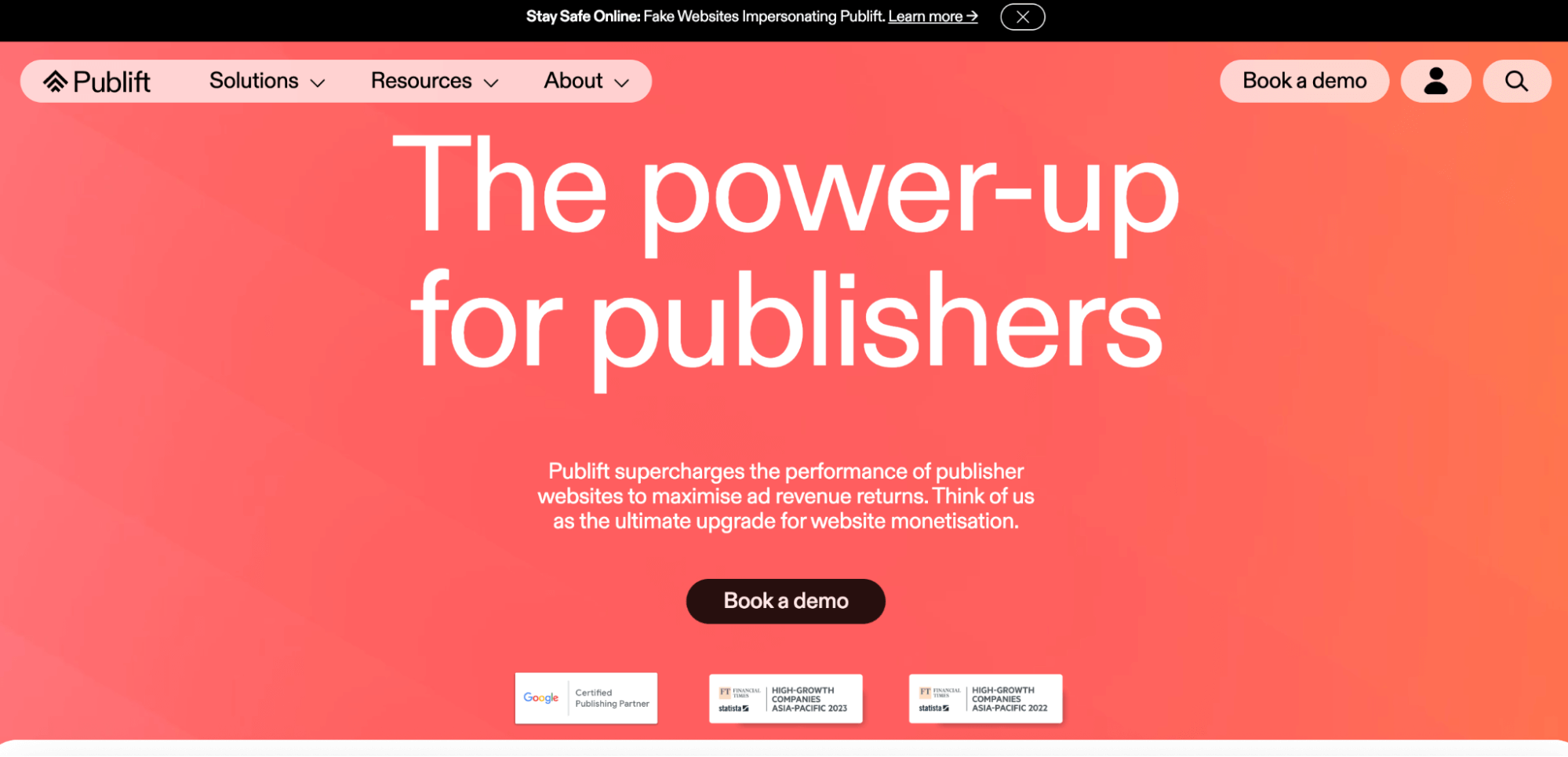
Publift isn’t a traditional ad network like Taboola. Instead, it’s an ad management platform that helps publishers optimize revenue across multiple demand sources. Think of it as a partner that fine-tunes your monetization strategy rather than just plugging in a single network.
Why publishers choose Publift
- Header bidding technology
Publift integrates with 15+ demand partners, including Google, for higher competition and CPMs. Taboola is single-platform native.
- Advanced optimization
Publift provides holistic monetization strategies beyond only native, including display and programmatic.
- No large traffic requirements
Publift is accessible to small and medium publishers, whereas Taboola requires large traffic volumes.
Things publishers should consider
- Publift requires technical setup, but gives greater flexibility and transparency than Taboola.
- Taboola’s single-supplier approach may offer more brand safety but less yield optimization.
- Publift supports wider ad inventory and formats.
Who is Publift best for
- Publishers wanting programmatic optimization, not just native ads.
- Small to medium sites, including blogs, wanting access to multiple demand sources for revenue.
7. Setupad
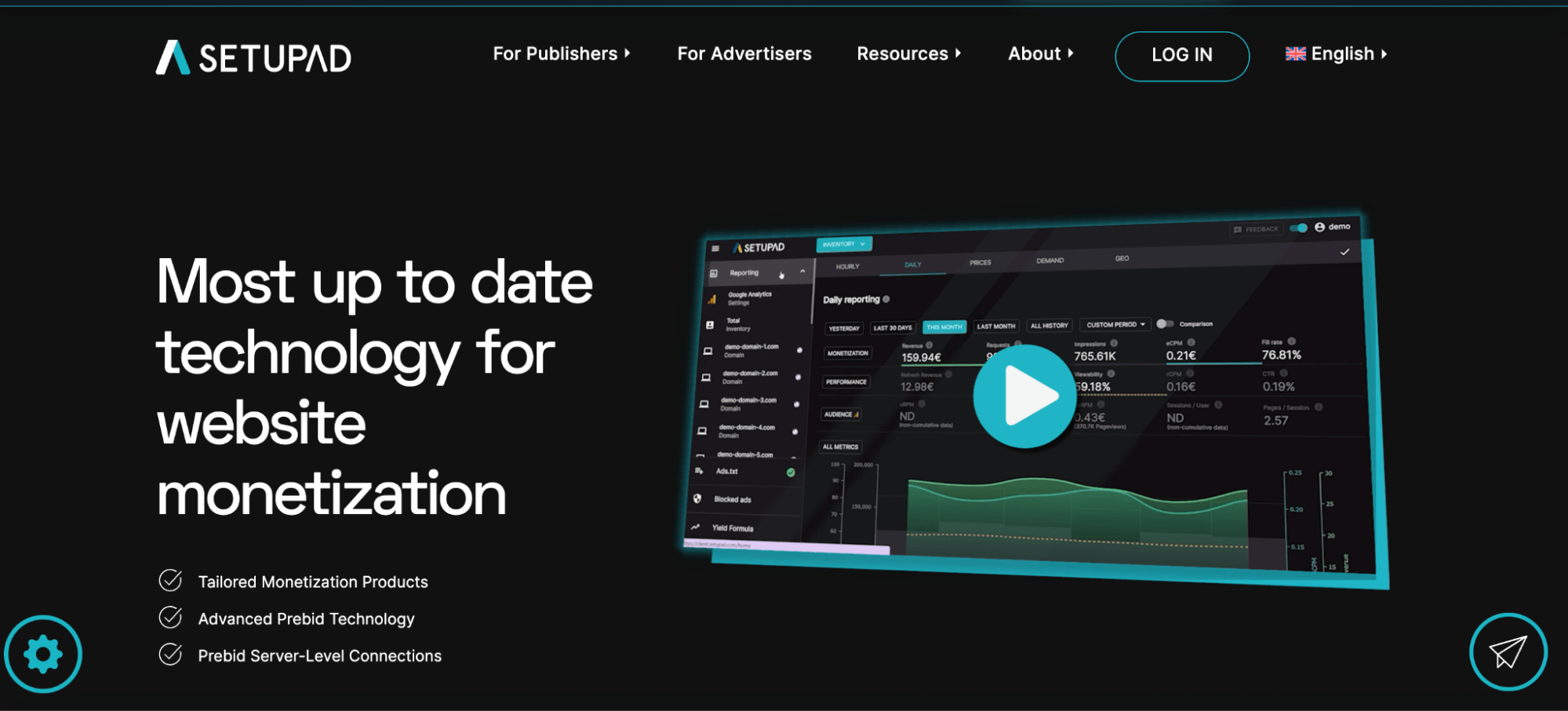
Setupad is another strong option if you’re looking for an alternative to Taboola, especially if site performance and SEO matter to you. Unlike Taboola, which mainly focuses on native content recommendations, Setupad uses header bidding technology to maximize revenue across multiple demand sources.
Why publishers like Setupad
- Programmatic and header bidding focus
Setupad connects publishers to 15+ supply-side partners using header bidding, boosting yield and CPMs. - Flexible inventory
Easily integrates banners, video, native, and programmatic formats vs. Taboola’s strict native. - No heavy traffic requirements
Setupad is accessible to smaller and medium publishers.
Things publishers should consider
- Setupad has technical onboarding, but offers significant yield boosts and control.
- Taboola is better for pure native, high-brand placements; Setupad is best for diversified ad strategies, including programmatic display and video.
- Setupad offers high compatibility with Google and other leading networks.
Who Setupad is best for
- Publishers wanting granular control and revenue optimization across formats.
- Those wanting to maximize monetization beyond native, especially medium-sized and growing sites.
How to choose the right Taboola alternative
With so many options out there, the best Taboola alternative really depends on your site’s size, goals, and audience. Here are a few factors to keep in mind when comparing platforms:
- Traffic requirements
Taboola and Outbrain usually work with big publishers, while networks like Monetag and Adsterra welcome smaller sites too. - Ad formats
If you want the same style of native ads as Taboola, go with MGID or Adblade. For more variety (push, pop, banners, smartlinks), Monetag and Adsterra offer more flexibility. - Payouts
Some platforms, like Monetag, have weekly payouts starting at just $5, making them beginner-friendly. Others may require higher balances or longer wait times. - Site performance
Tools like Setupad and Publift focus on Core Web Vitals and programmatic efficiency, which is important if you care about SEO and UX. - Support and setup
Do you want a plug-and-play solution, or do you prefer expert guidance? Self-serve platforms like Adsterra are quick to start, while Publift and Setupad provide hands-on help for bigger publishers.
Final thoughts
Taboola ads remain a big name in the native advertising world, but they’re not always the right fit for every publisher.
High traffic requirements, limited flexibility, and sometimes less-than-ideal Taboola pricing can make it tough for smaller sites to succeed.
The good news? There are plenty of alternatives to Taboola, from native-first platforms like Outbrain and MGID, to more flexible networks like Monetag and Adsterra, and even advanced programmatic solutions such as Setupad and Publift. Each one has its strengths depending on your goals.

